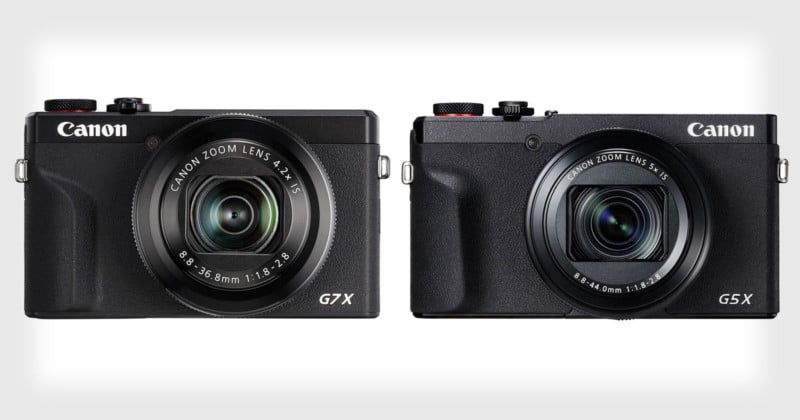Manufacturers Were Unprepared for the Point And Shoot Camera Revival
![]()
Point-and-shoot cameras are having a moment right now, but many now-popular models have been long forgotten by manufacturers. Cameras are selling with high markups on eBay and used marketplaces, and the latest generation of pocketable compact models from 2019 are widely sold out.
Point-and-shoot cameras have become incredibly popular with influencers and celebrities on TikTok in the past couple of years, and videos and posts with the hashtag #Digicam are gaining millions of views. PetaPixel has previously reported on this trend — which is something of a mix between Gen Z’s newfound nostalgia for the post-Y2K aughts aesthetic combined with the realization of how much better a digital camera is compared to a smartphone’s over-processed computational photography.
In general, it’s great that young people are discovering the joys of shooting photos with a dedicated photography camera like a point-and-shoot. There’s just one problem: camera manufacturers stopped making many of the desired cameras years ago.
As PetaPixel wrote last week, worldwide camera sales have drastically collapsed between 2010 and 2023. Within that period, the market dropped off 94%, “wiping out decades of growth” as data journalist Felix Richter described in his report on Statista. There are several factors to blame here, including the global chip shortage that occurred during the COVID-19 pandemic in 2020. Many camera brands faced decisions to discontinue older models prematurely.
In the wake of the pandemic, it felt like the camera industry was trapped between high demand and limited production ability. Especially regarding the higher end of the professional market. But what about the lower consumer and enthusiast end? Well, point-and-shoot cameras were also a casualty.
Naturally, smartphones are a significant culprit, replacing the need for anyone to buy a dedicated camera for casual, everyday photography. And for younger members of Gen Z, who never knew a time before the internet, an iPhone camera is all anyone needs for social media posts. Tech companies like Apple and Google spent most of the 2010s focusing on improving the capabilities of the imaging technology in their phones — adding multiple lenses and larger sensors and introducing computational processing for faux-HDR. The look of an iPhone photo is something we all became used to.
As a result, 2019 saw the last major point-and-shoot releases from Canon, Nikon, and Panasonic. While Sony’s latest photography-first point-and-shoot, the RX100 VII, also released in 2019, newer pocket-sized models like the ZV-1 II and ZV-1F have shifted towards focusing on vlogging and content creation.
Capturing Nostalgia
All of this brings us back to TikTok (a sentence I never thought I would ever write), where influencers have made using cameras like the Canon G7X Mark II trendy again. On the one hand, there are physical differences on the optical level to what the latest iPhone and Google Pixel cameras are trying to replicate digitally — where phone pictures are often flat and lacking definition in the attempt to render images with an incredibly wide dynamic range, TikTokers are realizing that portraits from digital cameras have contrast depth and more pleasing color science. On the other hand, there’s the nostalgia for a moment in time that has come and gone.

2020 forced everyone inside, and many turned to the platform as a way to distract from the frightening situation outside and find (or produce) new forms of entertainment. For Millennials, the pandemic was frustrating more than anything else. Career paths were put on hold, day-to-day workflows needed to adjust to remote procedures, and people with spouses, roommates, or families had to relearn how to cohabitate and co-function in close quarters. Despite the difficulties of the time (and there were plenty — many significantly more serious than the inconvenience of life-interrupted), Millennials at least spent their formative young adult years living their best lives. On the other hand, the pandemic was an entirely different situation for Gen Z.
Young people were just about to take that step into the independence of adulthood. Many were graduating college or high school or were smack in the middle of already enjoying those formative years. They didn’t already have copious Facebook photo albums of their 20s or teenage years like their slightly elder counterparts — the opportunities for creating those memories were taken from them. As a result, a shared collective nostalgia for the early 2000s has formed in the years since the pandemic.

One such piece of nostalgia (aside from fashion and Disney’s decision to release an album of covers from 2000’s pop-punk bands… ) is how digital cameras from the mid-2010s rendered photos. During the pandemic, Gen Z-ers had much time to mess around with the old point and shoots tucked in their parents’ junk drawers.
The Process Of Photography
Another part of the equation for point-and-shoot cameras returning to the zeitgeist undoubtedly has to do with the process of taking photos itself. The craft of photography and the tactile nature of framing a shot with intent, dialing in settings, and pressing the shutter button is an undeniably unique experience in relation to firing off a Live photo from a smartphone camera. Photographer Markus Hofstaetter recently discussed that tactile experience in a YouTube video comparing the analog vs digital Leica M cameras.
![]()
The act of pushing a physical button to take a photo is so ubiquitous that it’s the American Sign Language sign for “camera” and “take a picture.” Additionally, PetaPixel has even reported on rumors that suggest Apple might add a physical shutter button to the iPhone 16.

So it seems that part of the collective 2000s nostalgia also includes the time when people carried around dedicated pocketable cameras for taking everyday snapshots — not just for the look they produce, but because of the act of taking photos itself is something worth enjoying. Sure, working photographers might get a kick out of the many TikTok influencers now realizing just how much work goes into taking and processing photos when using a real camera versus a smartphone, but carrying an extra device around at parties and having to deal with SD cards and file management comes with the territory of producing quality, memory-making images.
What’s on the Market Today?
The issue that camera manufacturers are now facing, as a result of the compounding effects of this nostalgia and the collapse of the consumer-level camera market, is how to meet the demand. Unfortunately, many brands just aren’t making these cameras anymore.

At the time of this writing, most online camera retailers, from B&H and Adorama down to Best Buy and Target, are all sold out of their point-and-shoot stock. A quick search on eBay for a G7X Mark II will find a considerable markup for the devices, sometimes as high as $1,500 — just about double what the camera sold for when it was released almost a decade ago.
![]()
![]()
Peer-to-peer sale sites like Facebook Marketplace are rife with scammers. I spent the past few weeks responding to every listing for a G7X in the greater Los Angeles area. I was surprised with just how difficult it was to find any authentic listing that wasn’t trying to get me to pay electronically for an item they would ship to me (A PSA: always meet in person in a public area or safe space like a police station, and always deal in cash).
Amazon currently has some unbranded point-and-shoot cameras available, though it’s unclear where they’re coming from or who is making them. And Minolta appears to have released a cheap point-and-shoot for just $99.
Some brands still produce point-and-shoot cameras, but they are not in the same category. Fujifilm’s X100 series, though technically an all-in-one, like point-and-shoot cameras, is more geared towards professional photographers and competes primarily with Leica. Ricoh’s GR III series is a widely popular point-and-shoot with a fixed prime lens on an APS-C sensor. Still, it, too, is more of a pocketable camera for pros and enthusiasts on the go rather than the small-sensor all-in-ones that you might find on someone’s wrist at a wedding or party.
Other companies are taking on this demand for nostalgia via different means. App developers like Mood.camera are attempting to capture bring a vintage look to smartphone cameras by overriding many of the computational functions going on under the hood. It’s similar to apps like Blackmagic Camera are stripping away the phone’s processing to create a more cinematic look (and ironically, software like this makes me nostalgic for the days we hacked our DSLRs’ firmware with Magic Lantern to give us more control over images).
Meanwhile, Samyang has recently released a lens for Sony E-Mount with an optical exchange to swap focal lengths while maintaining a vintage look. Fujifilm’s Instax instant camera is widely popular to this day. And Sandmarc has a line of vintage filters that attach to iPhone lenses. (Hardware like this is making me nostalgic for the days we used 35mm adaptors to rig photography lenses to the fronts of our camcorders.)
What’s Next For Point And Shoots?
PetaPixel wrote a bit of an obituary for point and shoots in 2022. Still, given the resurgence these cameras are experiencing via social media influencers and our collective nostalgia for pre-AI digital photography, it’s unclear what the future of the entry-level camera market might be. “The reports of my death are greatly exaggerated,” Mark Twain famously said. It seems the same can be said for point-and-shoot cameras.
As evidenced by how much people are willing to spend on these cameras via used and third-party marketplaces, and how quickly any remaining restocks that might exist are selling out (thanks in part to dedicated Facebook groups and Reddit threads), it’s possible we could see the point-and-shoot camera rising from the ashes of a market destroyed by smartphones. Now we’re not going to see a Canon G7X Mark IV or Sony RX100 VIII in the immediate future, but manufacturers are eventually going to have to recognize the nostalgic demand for these cameras has never been higher.
Until then, we might just have to settle for covering our phone cameras with plastic wrap.
Image credits: Featured image created using an asset licensed via Depositphotos.